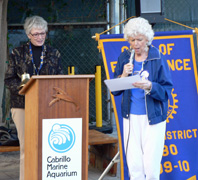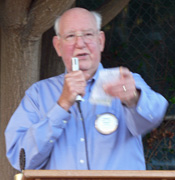Cabrillo Marine Aquarium
Posted by Wesley Bradford
on Jul 30, 2013


After President Sandy Farrell opened the off-site meeting at the Cabrillo Marine Aquarium, Charley Ferraro (now Executive Director of the Friends of Cabrillo Marine Aquarium) introduced Mike Schaadt (Executive Director of the Cabrillo Marine Aquarium) and his staff. Following the presentation, we had small-group tours of the exhibits, which include plankton raising, rockfish (which can live to 200 years), abalone, seahorses and their pipefish relatives, garibaldi’s (California’s state marine fish, named after the 19th century Italian political and military leader because of its bright orange color), jellyfish, sea mammals and birds, and the great diversity of Southern California marine life caused by upwelling deep colder waters that carry more nutrients up toward the shore, and the influence of El Niño weather conditions when more tropical water and animals come north to our coastline.
The Aquarium originated in 1935 as a collection of marine specimens stored in the Cabrillo Beach Bathhouse. In 1949, John Olguin, captain of the Cabrillo Beach lifeguards, was appointed director. He popularized the Aquarium by providing an evening program of viewing the grunion mating practices on the beach, timed by the lunar cycle and tide flow.
In 1981, the new museum building opened, designed by Frank Gehry. It expanded its public program sector, and another building expansion was opened in 2004. The building has indoor and outdoor exhibit spaces, auditorium, wet laboratories and offices around a central open space. Free-standing tanks are equipped with electrical and plumbing systems to display mechanical functions such as surf actions on the beach and along rocky shorelines.
The Aquarium is operated by the Department of Recreation and Parks, City of Los Angeles. Its programs include Ocean Outreach, Sea Rangers, Discovery Labs, Exploration Center, S Mark Taper Foundation Courtyard, Aquatic Nursery and Research Library. In addition to foundations, the primary support group is Friends of the Cabrillo Marine Aquarium.
There are programs for school groups, individuals and families, including visits to the adjacent beach and tide pools. Research programs for volunteers include coastal monitoring projects and student research mentoring. There is research on the effects of pollution, habitat loss, overfishing, and climate change.
One of the most popular programs is gathering on the beach in the evening to watch “Grunion Runs”. Grunion fish are known for their unusual mating ritual, where the females swim up onto sandy beaches at high tide in the evening, between 2 and 6 nights after the full and new moon from March through August, and continuing for several hours. They dig a hole with their tails to lay their eggs, buried up to their pectoral fins. The males approach and try to mate by curving around the female’s body and releasing their milt as the eggs are deposited about 4 inches below the surface. The milt flows down her body to fertilize the eggs, as the males retreat back to the ocean. Then the female twists free and returns to the ocean on the next wave.
Grunion eggs incubate a few inches deep in the sand above the level of subsequent waves, subject to being eaten by shorebirds and sand-dwelling invertebrates. They hatch about 10 days later, when the next high tide comes in. At the right moment, the mechanical agitation of the waves triggers hatching in less than 1 minute. This can be demonstrated in the Aquarium for visitors by agitating a few tiny eggs in a small glass jar, and the tiny fish can be seen quickly hatching and swimming. When they hatch on the beach, they immediately swim away on the next high wave. They grow to a length of 6-7 inches. They have no teeth, and their diet consists of plankton and brine shrimp.
The Aquarium welcomes volunteers to help educate thousands of visitors about Southern California’s marine environment. Volunteers serve in many capacities, in front of the public and behind the scenes, and every job provides meaningful experiences. The Friends of Cabrillo Marine Aquarium welcomes individual and corporate donations and membership. Visiting hours are Noon-5 on Tuesday through Friday, and 10-5 on Saturday and Sunday. The Aquarium is located at 3720 Stephen M White Drive in San Pedro, at the southern end of Pacific Ave, phone (310) 548-7562. Parking is free. The website is http://www.cabrillomarineaquarium.org/.